Question 1.
What do you mean by electric current?
(OR)
Define electric current.
Answer:
Electric current is defined as the amount of charge crossing any cross-section of the conductor in one second.
Question 2.
Which type of charge (positive or negative) flows through an electric wire when it is connected in an electric circuit?
Answer:
Negative type of charge flows through an electric wire when it is connected in an electric circuit.
Question 3.
Is there any evidence for the motion of charge in daily life situations?
Answer:
Yes, lightning is a live example.
Improve Your Learning
Question 1.
Explain how electron flow causes electric current with Lorentz - Drude theory of electrons. (AS1)
(OR)
How does electron flow cattle elfectric current with Lorentz - Drude theory of electrons? Explain.
Answer:
Lorentz - Drude theory :
- Lorentz - Drude proposed that conductors like metals contain a large number of free electrons.
- The positive ions are fixed in their locations. The arrangement of the positive ions is called lattice.
- The negative ions (electrons) move randomly in lattice in an open circuit.
- When the lattice is closed the electrons are arranged in ordered motion.
- When the electrons are in order motion, there will be a net charge (crossing through any cross section.
- This order motion of electrons is called electric current.
Question 2.
How does a battery work? Explain. (AS1)
(OR)
How does a battery maintain a constant potential difference between its terminals?
Answer:
Working of a battery :
- A battery consists of two metal plates (positive electrode = anode and negative electrode = cathode) and a chemical (electrolyte).
- The electrolyte between the two metal plates consists of positive and negative ions which move in opposite directions.
- The electrolyte exerts a chemical force on these ions and makes them move in a specified direction.
- Depending upon the nature of the chemical, positive ions move towards one of the plates and accumulate on that plate.
- As a result of this accumulation of charges on this plate it becomes anode.
- Negative ions move in a direction opposite to the motion of positive ions and accumulate on the other plate.
- As a result of this the plate becomes negatively charged called cathode.
- This accumulation of different charges on respective plates continues till both plates are sufficiently charged.
- But the ions in motion experience electric force when sufficient number of charges are accumulated on the plates.
- The motion of ions continues towards their respective plates till the chemical force is equal to electric force.
- Thus the battery works.
Question 3.
Write the difference between potential difference and emf. (AS1)
Answer:
Potential Difference:
Work done by the electric force on unit charge is called potential difference.
V = W/q = Fl/q
Electromotive force (emf):
The work done by the chemical force to move unit positive charge from negative terminal to positive terminal of the battery.
?= W/q = Fd/q
Question 4.
How can you verify that the resistance of a conductor is temperature dependent? (AS1)
(OR)
How do you prove increase in temperature affects the resistance with an activity?
Answer:
Resistance :
The resistance of a conductor is the obstruction offered to the flow of electrons in a conductor.
Resistance is temperature dependent:
Aim:
To show that the value of resistance of a conductor depends on temperature for constant voltage between the ends of the conductor.
Materials required :
- A bulb
- A battery
- Key
- Insulated wire
- Multimeter
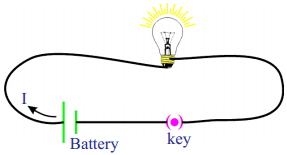
Procedure :
- Take a bulb and measure the resistance when it is in open circuit using a multimeter.
- Note the value of resistance in your notebook.
- Connect a circuit with components as shown in figure.
- Switch on the circuit. After few minutes, measure the resistance of the bulb again.
- Note this value in your notebook.
Observation :
- The value of resistance of the bulb in second instance is more than the resistance of the bulb in open circuit.
- The bulb gets heated.
Result:
The increase in temperature of the filament in the bulb is responsible for increase in resistance of the bulb.
Question 5.
What do you mean by electric shock? Explain how it takes place. (AS1)
Answer:
Electric shock:
The electric shock is combined effect of potential difference, electric current, and resistance of the human body.
- An electric shock can be experienced when there exists a potential difference between one part of the body and another part.
- When current flows through human body, it chooses the path which offers low resistance.
- The resistance of a body is not uniform throughout it.
- As long as current flow continues inside the body, the current and resistance of human body go on changing inversely.
- This is called the electric shock.
Question 6.
DeriveR= ρl/A. (AS1)
(OR)
What are laws of resistance and derive a formula for resistance.
Answer:
Resistance of a conductor is directly proportional to the length of the conductor,
i.e., R ∝ l ………………….. (1)
Resistance of a conductor is inversely proportional to the cross-section area of the conductor.
i.e., R ∝1/A ………………….. (2)
From (1) and (2) R ∝R∝lA⇒R=ρl/A
where ρ is a constant,
ρ is called specific resistance or resistivity.
Question 7.
How do you verify that resistance of a conductor is proportional to the length of the conductor for constant cross-section area and temperature? (AS1)
Answer:
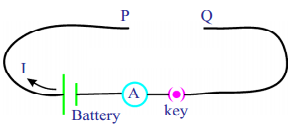
- Collect manganin wires of different lengths with the same cross-sectional areas.
- Make a circuit as shown in figure.
- Connect one of the manganin wires between the ends P and Q.
- Measure the value of the current using the ammeter.
- Repeat the same for other lengths of the wires.
- Note the values of currents.
- We notice that the current decreases with increase in the length of the wire.
∴ R ∝ l (at constant temperature and cross-section area) …………… (1)
- Do the same with manganin wires with equal lengths but different cross-section area.
- We notice that the resistance was more when the cross-section area was less.
∴ R ∝ 1/A ....... (2)
Thus we verify l and A.
Question 8.
Explain Kirchhoff’s laws with examples. (AS1)
(OR)
Write two examples of Kirchhoffs laws and explain it.
Answer:
Kirchhoff’s laws :
Two simple rules called Kirchhoff’s rules are applicable to any DC circuit containing batteries and resistors connected in any way.
The two laws are (i) Junction law and (ii) Loop law.
i) Junction law :
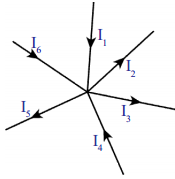
Here P is called junction point where conducting wires meet. The junction law states that, at any junction point in a circuit where the current can divide, the sum of the currents into the junction must equal the sum of the currents leaving the junction.
i.e., I1+ I4+ I6= I2+ I3+ I5
This law is based on the conservation of charge.
ii) Loop law:
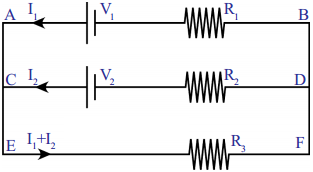
Loop law states that, the algebraic sum of the increases and decreases in potential difference (voltage) across various components of the circuit in a closed circuit loop must be zero.

This law is based on the conservation of energy.
Question 9.
What is the value of 1 KWH in Joules? (AS1)
Answer:
1 KWH = 1 KW x 1h
= 1000 W × 60 min = 1000 W × 60 × 60 s = 3.6 × 106Ws = 3.6 × 106J.
∴ 1 KWH = 3.6 × 106J.
Question 10.
Explain overloading of household circuit. (AS1)
Answer:
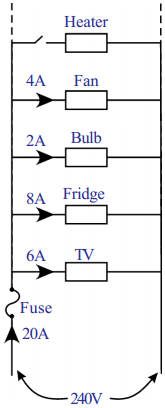
- Electricity enters our homes through two wires called lines. These lines have low resistance and the potential difference between the wires is usually about 240 V.
- All electrical devices are connected in parallel in our home. Hence, the potential drop across each device is 240 V.
- Based on the resistance of each electric device, it draws some current from the supply. Total current drawn from the mains is equal to the sum of the currents passing through each device.
- If we add more devices to the household circuit the current drawn from the mains also increases.
- This leads to overheating and may cause a fire. This is called “overloading”.
Question 11.
Why do we use fuses in household circuits? (AS1)
(OR)
What is the use of fuses?
Answer:
- The fuse consists of a thin wire of low melting point.
- When the current in the fuse exceeds 20 A, the wire will heat up and melt.
- The circuit then becomes open and prevents the flow of current into the household circuit.
- Hence all the electric devices are saved from damage that could be caused by overload.
- Thus we can save the household wiring and devices by using fuses.
Question 12.
Deduce the expression for the equivalent resistance of three resistors connected in series. (AS1)
(OR)
Derive R = R1+ R2+ R3
(OR)
The second end of a first resistor is connected to first end of second resistor. Then how are the resistors connected? Derive the expression for the resultant resistance of this connection.
Answer:
Series connection:
In series connection of resistors, there is only one path for the flow of current in the circuit. Hence, the current in the circuit is equal to I.
According to Ohm’s law,
∴ V1= IR1; V2= IR2and V3= IR3.
⇒ Let R be the equivalent resistance of the combination of resistors in series.

Also V = I Req
V = V1+ V2+ V3
I Req= IR1+ IR2+ IR3
⇒ I Req= I (R1+ R2+ R3)
⇒ Req= R1+ R2+ R3
∴ The sum of individual resistances is equal to their equivalent resistance when the resistors are connected in series.
Question 13.
Deduce the expression for the equivalent resistance of three resistors connected in parallel. (AS1)
(OR)
Derive :1R=1R1+1R2+1R3
(OR)
Explain the expression for the equivalent resistance of three resistors which are connected in parallel.
(OR)
If all the first ends of resistors are connected to and second ends are connected to another point, then what type of connection is this? Derive the resultant resistance for this connection.
Answer:
Parallel Connection :
In parallel connection of resistors, there is same potential difference at the ends of the resistors. Hence the voltage in the circuit is equal to V.
Let Ip I2 and I3 be the currents flowing through R1, R2,and R3resistors respectively.
Hence, we can write I = I1+ I2+ I3.
According to the Ohm’s law,
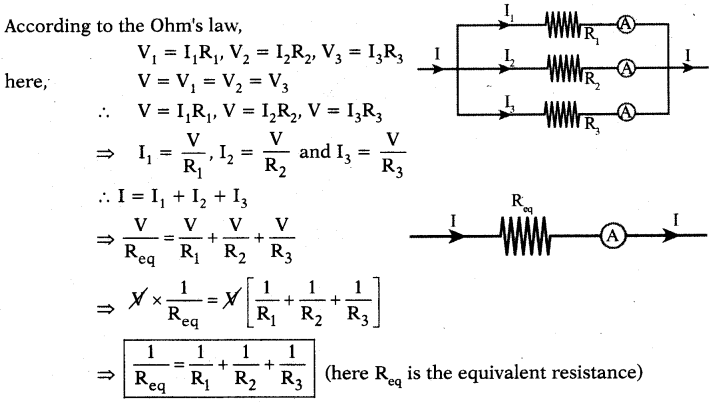
∴ The equivalent resistance of a parallel combination is less than the resistance of each of the resistors.
Question 14.
Silver is a better conductor of electricity than copper. Why do we use copper wire for conduction of electricity? (AS1)
Answer:
Silver is costlier than copper. So, we use copper wire for conduction of electricity even though silver is a better conductor of electricity.
Question 15.
Two bulbs have ratings 100 W, 220 V and 60 W, 220 V. Which one has the greater resistance? (AS1)
Answer:
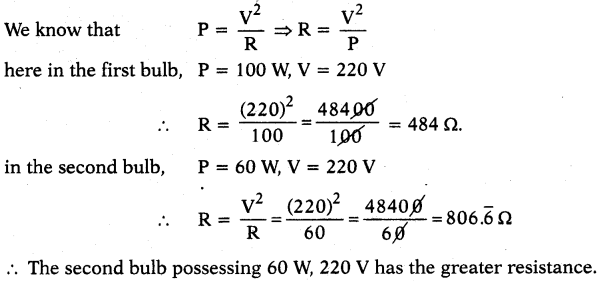
∴ The second bulb possessing 60 W, 220 V has the greater resistance.
Question 16.
Why don’t we use series arrangement of electrical appliances like bulb, television, fan, and others in domestic circuits? (AS1)
Answer:
- If one appliance, in a set of series combination breaks down, the circuit becomes open and the flow of current ceases. To avoid this the household appliances like bulb, T.V., fan, etc. are not connected in series. They are connected in parallel.
- In series combination same current passes through all resistors. This is not suggestable for household appliances. Hence, they are connected in parallel.
Question 17.
A wire of length 1 m and radius 0.1 mm has a resistance of 100 ?. Find the resistivity of the material. (AS1)
Answer:
1) Given l = 1 m, r = 0.1 mm = 10-4 m, R = 100 ?

Question 18.
Why do we consider tungsten as a suitable material for making the filament of a bulb? (AS2)
(OR)
What is the reason for using Tungsten as a filament in electric bulb?
Answer:
Tungsten has higher resistivity values and melting point. So, we consider tungsten as a suitable material for making the filament of a bulb.
Question 19.
Are the head lights of a car connected in series or parallel? Why? (AS2)
Answer:
The headlights of a car are connected in parallel.
Reason :
- When they are connected in parallel, same voltage (RD) will be maintained in the two lights.
- If one of the light damaged, the other will work without any disturbance.
Question 20.
Why should we connect electric appliances in parallel in a household circuit? What happens if they are connected in series?
Answer:
- The electric appliances are connected in parallel in a household circuit. Because in parallel wiring if any electric appliance is switched off, other appliances don’t get off.
- If one appliance, in a set of series combination breaks down, the circuit becomes open and the flow of current ceases.
- To avoid this the household appliances like bulb, T.V., fan, etc. are not connected in series.